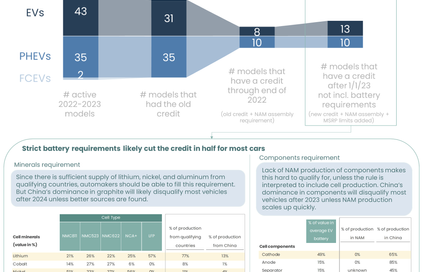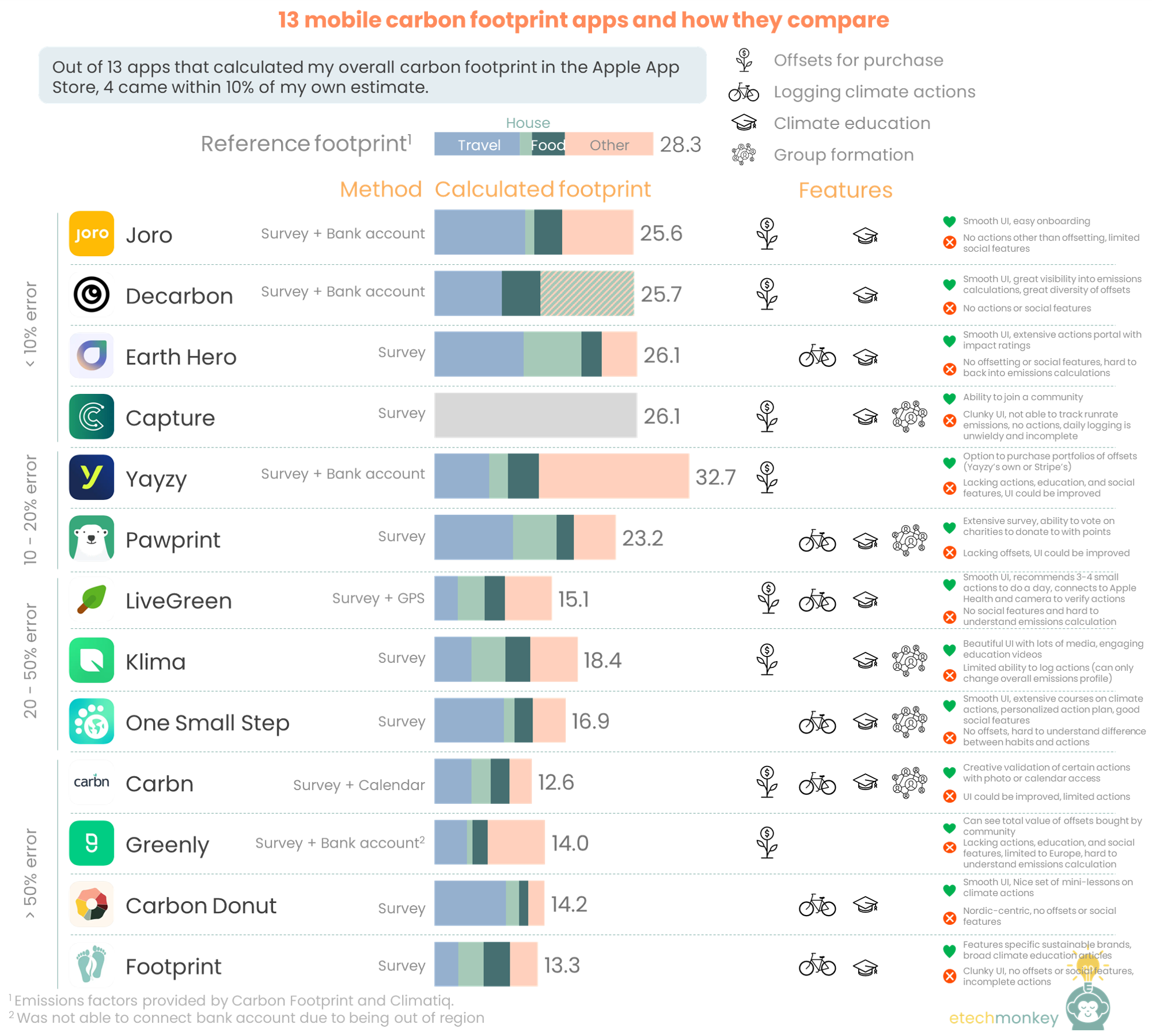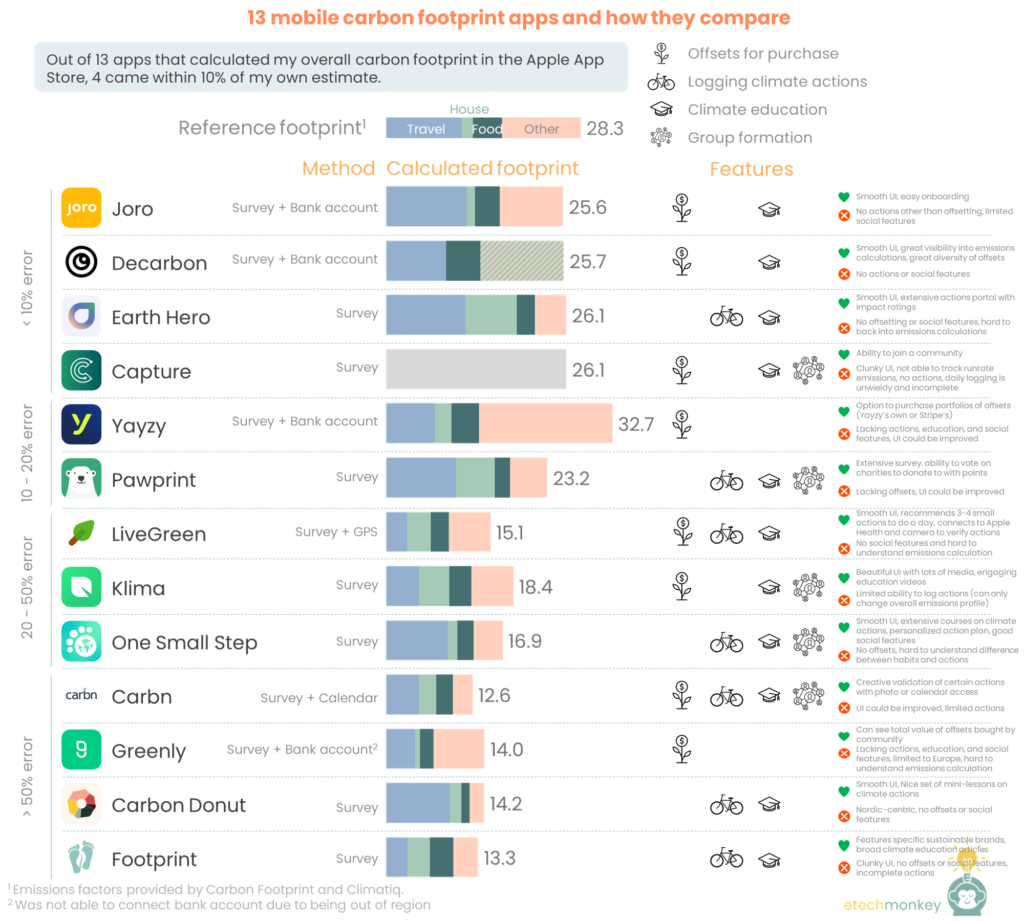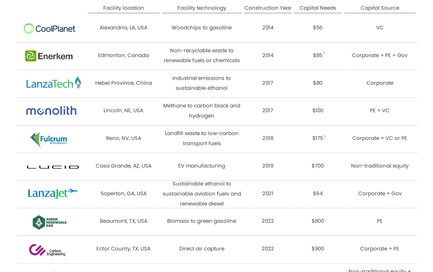
I downloaded 13 carbon footprinting apps and here’s what I found

Back to carbon footprinting! So after exploring carbon footprints around the world, how carbon footprints scale with wealth, and the general ecosystem of consumer sustainability software, I wanted to try out some of the consumer footprinting apps for myself.
First off, I had actually calculated my personal footprint using the same method from the previous posts. That served as a baseline for judging the accuracy of an app’s calculations. I’ve estimated my personal footprint to be ~28 tons (yikes!), with “splurge” categories being travel (flying about once a month), food (eating out), and discretionary purchases (this year has been a bit expensive because of moving but I also have an Amazon problem). For context, 28 is about twice the US median and in line with the average carbon footprint of someone in the upper middle class. It’s also 22x where the average person in developed nations should be by 2050. In other words, I’ve got my work cut out for me. And hopefully the apps can help!
I actually downloaded 21 apps to start off with. But six out of the 21 did not work for me for various reasons (CarbonTracker – couldn’t create an account, Earthly – couldn’t connect bank account, GreenFoot – clunky survey, SWRM – ungainly logging of individual actions, Offcents – not available in my region, Personal Carbon Footprint – was unable to load profile again after completing the survey). Another two out of the 21 were not included in the analysis to avoid an apples to orange comparison. Those two were Aerial, which tracks flight and rideshare emissions with email access, and Wren, which is a web app.
The rest, 13 apps, all successfully calculated current emissions but with varying degrees of accuracy. 4 out of the 13 were within 10% of the 28 number, 2 landed at around a 15-20% error rate, 3 had a 35-50% error rate, and the remaining 4 exceeded a 50% error rate. Most apps used surveys as either the main form of gathering data for emissions or as an accompaniment to bank account data.
The features of all of them also varied. 8 apps sold carbon offsets, 7 apps allowed the user to log carbon actions, 11 apps offered the user climate education in some form, and 5 apps included social features like group formation and group competitions.
A summary of my comparison below:

Links to the apps (add me as a friend!):
- Joro
- Decarbon
- Earth Hero
- Capture
- Yayzy
- Pawprint
- LiveGreen
- Klima
- One Small Step
- Carbn
- Greenly
- Carbon Donut
- Footprint
After using all of these apps for a period of time, here’s what I observed:
- The personal footprinting market is still in its early days. While itwas difficult to get real numbers on how many users each app had, there were a few datapoints that gave some clues. First, the number of reviews in the app store. Earth Hero had the most number of reviews at 392, followed by LiveGreen at 269, Carbn at 170, Klima at 154, and Joro at 130. For context, the average app in the App store has 455 reviews.
Earth Hero discloses the number of total users it has in its global stats – 86,429. That’s 220 users per reviewer…if we apply this 220:1 ratio across the reviews for each app and assume in the very bullish and unlikely scenario that each app has totally unique users, that’s 275,880 total people globally that are using these apps. Compare that to 588 million Apple users worldwide and you get 0.05% of the market. In other words, there are very few people actually using these apps and jury is still out on which one will take market share.
- Some surveys were difficult to answer unless you already have a firm grasp on your activity and energy use. When determining consumption, many questions asked how often you buy new or used clothes, how much you buy relative to the average consumer, how many times a week you ate meat, etc. I found some of these difficult to answer – for example, do I buy the average amount, more than the average amount, or way more than average amount of electronics? Do I buy 4 outfits a year or 12? That’s not something I intuitively know unless I have dived into my purchasing history in detail.
For someone who lives in an apartment, some of the energy questions were a little too biased to a homeowner. I don’t have a way to install solar panels in may apartment…in fact, I don’t even have a way to control the energy profile of my bill. I also don’t know how my water is heated or if the apartment uses gas for heat. I pay a single sum for utilities to my apartment and they control the rest.
Even travel was kind of hard. How many people know the number of hours they flew in 2021? Or even how many miles put on their car? I had to wrack my brain to estimate those numbers – and if I was an impatient app user, I might have just given up in the middle of the survey.
It seems like the easiest, most painless way to onboard a user – while also making sure the footprint is adequately accurate — is to use a combination of surveys and bank account information. Joro, Decarbon, and Yayzy all take this approach and use Plaid to protect user privacy. Greenly also does this but only connects to European accounts with an unknown service. - The calculations need to be more transparent. One thing that struck me was that, in seeing the large variance in footprint numbers across these different apps, it was hard understand exactly how these apps got to their numbers. For the vast majority of apps, the emissions factors used to calculate the footprints were not disclosed. As someone who was informed enough on emissions to want to use the app, curious enough to understand what actions I can take to reduce my emissions, and climate-incentivized enough to buy offsets for my emissions, I was a little frustrated at how low of a resolution most apps provided into what exactly was driving the numbers, especially since the numbers determined how much I would have to pay each month to offset my emissions.
One app that did this well was Decarbon. Decarbon was able to show me the carbon footprint of each individual transaction, its backup calculation, and the source(s) for the emissions factor used. That resolution gave me more comfort that the footprint it calculated was accurate, which made me feel more comfortable buying offsets based on those numbers.
- Incentivizing the user to change behavior is hard and accurately tracking that change is even harder. Gamification is not enough. Almost all the app makers had some gamification elements incorporated – points, leaderboards, challenges, streaks, levels, etc. Some had rewards like being able to spend points on trees planted or charities to donate to. There were also UI elements that provided the user with immediate gratification for a completed action – satisfying button presses, swipes, animated point totals that went up or CO2 emissions totals that went down.
All of these exist in an effort to engage the user regularly in carbon reduction actions. In my experience, and as someone who never really got into video games, these weren’t enough. I consistently just did the actions I already wanted to do, like recycling or adjusting the AC. For the things that I didn’t want to do, like taking a cold shower, I struggled to find the motivation for it, even if it did get me points that would put me on a leaderboard. It seemed much easier to just pay $10 to offset my emissions from water heating for a year.
And add to that, if I really was motivated by the points or levels, the tracking was usually easy to game. Some apps, like LiveGreen and Carbn, incorporated connections to cameras and Apple Health to reduce fraud, but most just relied on user input. It seems like the apps were trying to thread a needle – finding a user that was “almost green” who was motivated enough to download the app and to have gamification drive her to change behavior but honest enough to keep herself accountable to what her actual actions were.
The incentive is much stronger and the game much more fun if I can play with friends. So I see social features as a necessary part of these apps going forward (and it does seem like the apps without social features have it on their roadmap). But even with social features, it will be a constant race to try and make the game more interesting for the user if the incentives are driven by these gamification elements.
- Offsets varied widely in price and type and sometimes seemed a little too abstract for the average user to feel compelled to buy. The apps that had offsets by project charged anywhere from $7 to $154 per ton while the apps that had a single offset offering charged anywhere from $9 to $25 per ton. Most apps sold offsets related to forestry and renewable energy generation, but some also sold regen farming, cookstove deployment, carbon capture, and carbon sequestration projects. All in all, offsets varied a lot and for someone who isn’t in climatetech, the variance can feel overwhelming.
For me, I felt a little disconnected purchasing an offset. The apps usually provided some information on each project, but most were just at most a couple paragraphs about what and where the project was. It was hard to visualize how my offset contributed or made an impact on that project. I also had to have faith that the money would go to the project in some useful and productive way. For some people, perhaps a guilty conscience is enough to motivate them to buy an offset and trust that the offset is doing good, but for many, I suspect that we’ll need additional transparency about the offsets and what they’re doing for them to want to make the purchase.
Again, social features may overcome this. If it was en vogue to personally go carbon neutral, maybe the offset transparency doesn’t matter as much.
- All this to say that the apps are worth downloading. Anyone who cares about climate should try these apps, know their footprint number, help the developers make them better, and maybe even buy and offset or two. Some might argue that personal footprint apps are a distraction – that individuals can’t really make a difference to our emissions goals and that it’s better to focus on decarbonizing the backend infrastructure. But I think these apps play a key role in building a conscientious and climate-forward consumer base that can be an informed advocate for a net zero future.
Knowing how much my lifestyle has cost me in emissions has made me care more about the sustainability initiatives in industries I previously had little connection to. For example - not only will I think twice about that next Amazon purchase, I’ll be more interested in their zero-emissions shipping efforts knowing that they’ll reduce the impact of my bad shopping habits by half a ton. I think that alone has changed me as a consumer for the better.
TLDR; The personal carbon footprinting market is still small. There are things that can be improved in the apps around accuracy, usability, and features offered. But knowing and understanding my footprint number was a valuable exercise for me as a consumer.

